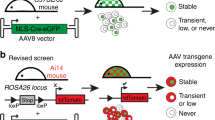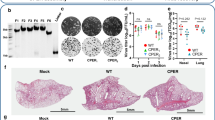Abstract
Although a large percentage of the world population is seropositive for exposure to various strains of adeno-associated virus (AAV), a human parvovirus, AAV has never been identified as an etiologic agent of human disease. Most likely contributing to the pronounced lack of pathogenicity is the fact that AAV is a naturally ‘defective’ virus that requires a helper virus for productive replication of its genome. Another unusual aspect of wild-type AAV biology is the ability of the virus to establish latent infection by preferential integration of its genome into a specific locus of human chromosome 19. Site-specific integration was a major impetus for the development of recombinant AAV vectors, which typically lack all AAV coding sequences. It was soon realized, however, that expression of at least one species of the virally encoded initiator proteins, Rep78 or Rep68, is necessary for targeted integration of AAV-derived DNA constructs to occur. This article will present a chronological outline of studies characterizing site-specific integration of wild-type AAV sequences and the quasi-random target site selection observed with recombinant AAV vectors.
This is a preview of subscription content, access via your institution
Access options
Subscribe to this journal
Receive 12 print issues and online access
$259.00 per year
only $21.58 per issue
Buy this article
- Purchase on Springer Link
- Instant access to full article PDF
Prices may be subject to local taxes which are calculated during checkout
Similar content being viewed by others
References
Atchison RW, Casto BC, Hammon WM . Adenovirus-associated defective virus particles. Science 1965; 149: 754–756.
Berns KI, Pinkerton TC, Thomas GF, Hoggan MD . Detection of adeno-associated virus (AAV)-specific nucleotide sequences in DNA isolated from latently infected Detroit 6 cells. Virology 1975; 68: 556–560.
Cheung AKM, Hoggan MD, Hauswirth WW, Berns KI . Integration of the adeno-associated virus genome into cellular DNA in latently infected human Detroit 6 cells. J Virol 1980; 33: 739–748.
Kotin RM, Berns KI . Organization of adeno-associated virus DNA in latently infected Detroit 6 cells. Virology 1989; 170: 460–467.
Kotin RM, Siniscalo M, Samulski RJ, Zhu X, Hunter L, Laughlin CA et al. Site-specific integration by adeno-associated virus. Proc Natl Acad Sci USA 1990; 87: 2211–2215.
Samulski RJ, Zhu X, Xiao X, Brook JD, Housman DE, Epstein N et al. Targeted integration of adeno-associated virus (AAV) into human chromosome 19. EMBO J 1991; 10: 3941–3950.
Kotin RM, Linden RM, Berns KI . Characterization of a preferred site on human chromosome 19q for integration of adeno-associated virus DNA by non-homologous recombination. EMBO J 1992; 11: 5071–5078.
Lamartina S, Sporeno E, Fattori E, Toniatti C . Characteristics of the adeno-associated virus preintegration site in human chromosome 19: open chromatin conformation and transcription-competent environment. J Virol 2000; 74: 7671–7677.
Ogata T, Kozuka T, Kanda T . Identification of an insulator in AAVS1, a preferred region for integration of adeno-associated virus DNA. J Virol 2003; 77: 9000–9007.
Giraud C, Winocour E, Berns KI . Site-specific integration by adeno-associated virus is directed by a cellular DNA sequence. Proc Natl Acad Sci USA 1994; 91: 10039–10043.
Weitzman MD, Kyostio SRM, Kotin RM, Owens RA . Adeno-associated virus (AAV) Rep proteins mediate complex formation between AAV DNA and its integration site in human DNA. Proc Natl Acad Sci USA 1994; 91: 5808–5812.
Im D-S, Muzyczka N . The AAV origin binding protein Rep68 ia an ATP-dependent site-specific endonuclease with DNA helicase activity. Cell 1990; 61: 447–457.
Owens RA, Weitzman MD, Kyostio SR, Carter BJ . Identification of a DNA-binding domain in the amino terminus of adeno-associated virus Rep proteins. J Virol 1993; 67: 997–1005.
Linden RM, Winocour E, Berns KI . The recombination signals for adeno-associated virus site-specific integration. Proc Natl Acad Sci USA 1996; 93: 7966–7972.
Urcelay E, Ward P, Wiener SM, Safer B, Kotin RM . Asymmetric replication in vitro from a human sequence element is dependent on adeno-associated virus Rep protein. J Virol 1995; 69: 2038–2046.
Balagué C, Kalla M, Zhang W-W . Adeno-associated virus Rep78 protein and terminal repeats enhance integration of DNA sequences into the cellular genome. J Virol 1997; 71: 3299–3306.
Surosky RT, Urabe M, Godwin SG, McQuiston SA, Kurtzman GJ, Ozawa K et al. Adeno-associated virus Rep proteins target DNA sequences to a unique locus in the human genome. J Virol 1997; 71: 7951–7959.
Kearns WG, Afione SA, Fulmer SB, Pang MG, Erikson D, Egan M et al. Recombinant adeno-associated virus (AAV-CFTR) vectors do not integrate in a site-specific fashion in an immortalized epithelial cell line. Gene Ther 1996; 3: 748–755.
Nakai H, Yant SR, Storm TA, Fuess S, Meuse L, Kay MA . Extrachromosomal recombinant adeno-associated virus vector genomes are primarily responsible for stable liver transduction in vivo. J Virol 2001; 75: 6969–6976.
Miao CH, Snyder RO, Schowalter DB, Patijn GA, Donahue B, Winther B et al. The kinetics of rAAV integration in the liver. Nat Genet 1998; 19: 13–15.
Fisher KJ, Jooss K, Alston J, Yang Y, Haecker SE, High K et al. Recombinant adeno-associated virus for muscle directed gene therapy. Nat Med 1997; 3: 306–312.
Thomas CE, Storm TA, Huang Z, Kay MA . Rapid uncoating of vector genomes is the key to efficient liver transduction with pseudotyped adeno-associated virus vectors. J Virol 2004; 78: 3110–3122.
Hauck B, Zhao W, High K, Xiao W . Intracellular viral processing, not single-stranded DNA accumulation, is crucial for recombinant adeno-associated virus transduction. J Virol 2004; 78: 13678–13686.
Nakai H, Iwaki Y, Kay MA, Couto LB . Isolation of recombinant adeno-associated virus vector-cellular DNA junctions from mouse liver. J Virol 1999; 73: 5438–5447.
Nakai H, Montini E, Fuess S, Storm TA, Grompe M, Kay MA . AAV serotype 2 vectors preferentially integrate into active genes in mice. Nat Genet 2003; 34: 297–302.
Nakai H, Wu X, Fuess S, Storm TA, Munroe D, Montini E et al. Large-scale molecular characterization of adeno-associated virus vector integration in mouse liver. J Virol 2005; 79: 3606–3614.
Miller DG, Trobridge GD, Petek LM, Jacobs MA, Kaul R, Russell DW . Large-scale analysis of adeno-associated virus vector integration sites in normal human cells. J Virol 2005; 79: 11434–11442.
Wang H, Lieber A . A helper-dependent capsid-modified adenovirus vector expressing adeno-associated virus Rep78 mediates site-specific integration of a 27-kilobase transgene cassette. J Virol 2006; 80: 11699–11709.
Gonçalves MAFV, van Nierop GP, Tijssen MR, Lefesvre P, Knaän-Shanzer S, van der Velde I et al. Transfer of the full-length dystrophin-coding sequence into muscle cells by a dual high-capacity hybrid viral vector with site-specific integration ability. J Virol 2005; 79: 3146–3162.
Cortés ML, Oehmig A, Saydam O, Sanford JD, Perry KF, Fraefel C et al. Targeted integration of functional human ATM cDNA into genome mediated by HSV/AAV hybrid amplicon vector. Mol Ther 2008; 16: 81–88.
Smith JR, Maguire S, Davis LA, Alexander M, Yang F, Chandran S et al. Robust, persistent transgene expression in human ES cells is achieved with AAVS1-targeted integration. Stem Cells 2008; 26: 496–504.
Acknowledgements
This work was supported by the Intramural Research Program of the National Heart, Lung, and Blood Institute, National Institutes of Health.
Author information
Authors and Affiliations
Corresponding author
Rights and permissions
About this article
Cite this article
Smith, R. Adeno-associated virus integration: virus versus vector. Gene Ther 15, 817–822 (2008). https://doi.org/10.1038/gt.2008.55
Received:
Accepted:
Published:
Issue Date:
DOI: https://doi.org/10.1038/gt.2008.55
Keywords
This article is cited by
-
Biomaterial-guided delivery of gene vectors for targeted articular cartilage repair
Nature Reviews Rheumatology (2019)
-
Targeting neuronal and glial cell types with synthetic promoter AAVs in mice, non-human primates and humans
Nature Neuroscience (2019)
-
Targeted in vivo knock-in of human alpha-1-antitrypsin cDNA using adenoviral delivery of CRISPR/Cas9
Gene Therapy (2018)
-
Multidimensional Genome-wide Analyses Show Accurate FVIII Integration by ZFN in Primary Human Cells
Molecular Therapy (2016)
-
Recurrent AAV2-related insertional mutagenesis in human hepatocellular carcinomas
Nature Genetics (2015)



